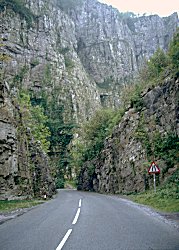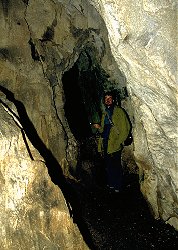Cheddar Gorge & Caves
Cheddar Showcaves - Gough’s Cave - Cox’s Cave - Cheddar Caves & Gorge
Useful Information


| Location: |
A371 between Weston-super-Mare and Wells.
M5 exit J22, A38 north 11 km to Cheddar, follow brown tourist signs. From Bristol A38 then A371 and B3135. From Bath A39 then B3135. (51.281911, -2.766628) |
| Open: |
All year daily 10-17. Last tour 16:30. Closed 24-DEC, 25-DEC. [2024] |
| Fee: |
Caves & Gorge Explorer Ticket:
Adults GBP 24, Children (5-15) GBP 18, Children (0-4) free. [2024] |
| Classification: |
 Karst Cave Karst Cave
 The Most Expensive Show Cave The Most Expensive Show Cave
|
| Light: |
 Electric Light Electric Light
|
| Dimension: |
Cox’s Cave:
L=100 m. Gough’s Cave: L=3,405 m, VR=115 m. |
| Guided tours: |
L=820 m, St=100, D=45 min. V=260,000/a [2000] |
| Photography: | |
| Accessibility: | |
| Bibliography: |
Timeless Cheddar Caves,
guide book, available at caves.
D.T. Donovan (2006): Gough’s Cave, Cheddar, Somerset. Quaternary Stratigraphy Proceedings of the University of Bristol Spelæological Society. 24 (1): 17–35. pdf D.J. Irwing (1985): The Exploration of Gough’s Cave and its Development as a Show Cave Proceedings of the University of Bristol Spelæological Society. 17 (2): 95–101. pdf |
| Address: |
Cheddar Gorge & Caves, Cheddar Gorge, Somerset BS27 3QF, Tel: +44-1934-742343. E-mail: |
| As far as we know this information was accurate when it was published (see years in brackets), but may have changed since then. Please check rates and details directly with the companies in question if you need more recent info. |
|
History
| 1837 | Cox’s Cave discovered by Mr George Cox during a quarrying operation. |
| 1838 | Cox’s Cave opened to the public. |
| 1892 | Gough’s Cave discovered by Richard Cox Gough. |
| 1895 |  E.A. Martel, visited Cox’s Cave and declared that "out of 600 caves, Cox’s was admired the most". E.A. Martel, visited Cox’s Cave and declared that "out of 600 caves, Cox’s was admired the most". |
| 1898 | Gough’s Cave opened to the public. |
| 1899 | Electric light installed in Gough’s Cave. |
| 1903 | remains of a human male, named Cheddar Man, discovered in Cough’s Cave. |
| 1949 | Cox’s Cave surveyed by L.B. Thorneycroft |
| 1952 | Gough’s Cave surveyed by W.I. Stanton. |
| 1960 | Cox’s Cave surveyed. |
| 1965 | caves in the gorge surveyed by W.I. Stanton. |
| 15-SEP-1968 | cave flooded for three days during the Great Flood of 1968. |
| 1985-1990 | extensive flooded parts of the cave system were explored. |
| 1987 | Cox’s Cave connected to the artificial Pavey’s Cave by a tunnel. |
| 1987 | human skulls discovered, which were deliberately fashioned into ritual drinking cups or bowls. |
| 2010 | human bones discovered which were dated to 14,700 BP. |
Description
The Cheddar Gorge & Caves actually are two caves, the larger Gough’s Cave, and Cox’s Cave. They are a very British tourist venue with lots of not cave related "sights". The tour includes both caves and also the Cheddar Man Museum, a Dungeons & Dragons Adventure called the Crystal Quest, Jacob’s Ladder, Pavey’s Lookout Tower and an open-top bus tour of Cheddar Gorge. Some older descriptions notice a third cave, Waterfall Cave, which is today the place of the Crystal Quest, but in fact, it is a part of Cox’s Cave. The name of the cave and the tour was changed numerous times since it was opened as a show cave. Some years ago it was renamed Cheddar Gorge & Caves from formerly Cheddar Caves & Gorge. It is also known as Cheddar Showcaves, the plural is intended.
Cox’s Cave was discovered in 1837 by the mill owner George Cox while quarrying limestone for a new building. He opened the cave as a show cave in the following year, obviously after building some trails and after making a contract with the landowner. When he became too old, the cave was taken over by the landowner Thomas Thynne, 5th Marquess of Bath. The cave is rather small and completely developed, a large meandering passage leads to series of decorated rifts. There is a natural connection to Pavey’s Hole which is an artificial cave nearby. But as this passage was not suitable for cave tours, an artificial connection was blasted through in 1986. This allows a through-tour exiting through Pavey’s Hole.
Gough’s Cave was known in the 19th century, but only the entrance section which was called Sand Cave. In 1892 the retired sea captain Richard Cox Gough, who lived in Lion House in Cheddar, explored this cave. He discovered a new section of the cave, and between 1892 and 1898 he excavated and developed the cave. In 1898, he opened it to the public, and in the next year he installed electric light. The trails he installed are almost unchanged until today, and the Diamond Chamber is the end of the show cave until today. Nevertheless, the cave was explored further and is today almost 3.5 km long, a lot of it is the underground course of the Cheddar Yeo, which makes it the largest underground river system in Britain. Extensive flooded parts of the cave system were explored between 1985 and 1990. The river passage is accessible only by cave diving.
The cave contained skeletal remains of both humans and animals. Exceptional is that they all show cut-marks and breakage which are typical for de-fleshing and eating. There are Skull fragments of five to seven humans, including a 3-year-old and two adolescents. The brain cases were prepared as drinking cups, a thing which is known from other Magdalenian sites across Europe. The remains of a human male were discovered in Gough’s Cave in 1903 and named Cheddar Man. It was dated to 7150 BC and is thus Britain’s oldest complete human skeleton. A replica of the remains and a reconstruction based on his genetic markers are on display in the Cheddar Man Museum, the original remains are in the Natural History Museum in London. According to the reconstruction he had green eyes, lactose intolerance, and dark curly or wavy hair. And probably his skin was dark to very dark.
Further excavations in 2010 revealed human bones which were dated to 14,700 BP. The analysis of the scratch marks using 3D microscopy by Professor Chris Stringer of the Natural History Museum supports theories about cannibalism. This is quite exceptional as most theories of cannibalism were actually 19th century superstition. The team even stated that human skulls excavated in 1987 were deliberately fashioned into ritual drinking cups or bowls. As a result, the museum was renamed Cheddar Man and the Cannibals Museum.
A 15,000 years old device, made of reindeer antler, was interpreted as being a device for making rope.
A similar tool, made of 40,000 year old mammoth tusk, from the
 Hohler Fels
in Germany indicated that this technique had already become an important human activity by the Upper Paleolithic.
Such discoveries were called batons and were interpreted as badges of rank carried by chiefs.
But an experimental archaeology experiment by Veerle Rots of the University of Liège in Belgium proved that they can be used to make rope.
Rope was obviously of great use for our ancestors and of great importance.
Hohler Fels
in Germany indicated that this technique had already become an important human activity by the Upper Paleolithic.
Such discoveries were called batons and were interpreted as badges of rank carried by chiefs.
But an experimental archaeology experiment by Veerle Rots of the University of Liège in Belgium proved that they can be used to make rope.
Rope was obviously of great use for our ancestors and of great importance.
The name Cheddar is always connected with the Cheddar cheese. And really, this is actually the place where the cheese comes from. The karst area is not suitable for agriculture, it was thus used as meadows for feeding cows, and the caves and cellars in the limestone are an ideal place to store and mature the cheese. There is even a cheese store in the show cave which can be seen during the tour.
As we mentioned at the beginning, this is not a normal show cave. It is a sort of British theme park with numerous parts and a single ticket. If you just want to visit the cave, the fee is quite annoyingly high, but if you want to have an interesting day, it’s actually okay. Unfortunately, there is no possibility to visit just the cave. If you look at travel portals on the web, you will see that the site has rather poor ratings This is simply because numerous visitors would prefer to visit just the cave. And some visitors felt screwed when they discovered that they paid a rather high fee for the cliff walk, the trail around the gorge. The point is that there are four access points and only one requires a fee at all, so if you start at one of the other three, the walk is free.
The open hours and entrance fees are pre-Corona. It seems this venue was hit even harder by the pandemic than other tourist venues, and it was partly and completely closed for some time. Currently, even the web page was replaced by a simple statement that they will reopen in April, no year given.
- See also
 The Caves of Cheddar Gorge, text from: Tony and Anne Oldham (1972): Discovering Caves - A guide to the Show Caves of Britain.
The Caves of Cheddar Gorge, text from: Tony and Anne Oldham (1972): Discovering Caves - A guide to the Show Caves of Britain. Search DuckDuckGo for "Cheddar Cave"
Search DuckDuckGo for "Cheddar Cave" Google Earth Placemark
Google Earth Placemark Gough’s Cave - Wikipedia (visited: 09-JUL-2021)
Gough’s Cave - Wikipedia (visited: 09-JUL-2021) Cox’s Cave - Wikipedia (visited: 25-JAN-2022)
Cox’s Cave - Wikipedia (visited: 25-JAN-2022) Cheddar Gorge & Caves, official website (visited: 25-JAN-2022)
Cheddar Gorge & Caves, official website (visited: 25-JAN-2022) Gavin’s Adventures on the Mystical Island of Britain -- Part 19 (visited: 22-NOV-2024)
Gavin’s Adventures on the Mystical Island of Britain -- Part 19 (visited: 22-NOV-2024) Cox’s Cave - Mendip Cave Registry (visited: 22-NOV-2024)
Cox’s Cave - Mendip Cave Registry (visited: 22-NOV-2024) Gough’s Cave - Mendip Cave Registry (visited: 22-NOV-2024)
Gough’s Cave - Mendip Cave Registry (visited: 22-NOV-2024)
 Index
Index Topics
Topics Hierarchical
Hierarchical Countries
Countries Maps
Maps